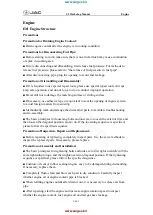
Tire Inspection and Rotation
Tires should be rotated every 5,000 to 8,000 miles
(8 000 to 13 000 km).
Any time you notice unusual wear, rotate your tires as
soon as possible and check wheel alignment. Also
check for damaged tires or wheels. See
for New Tires on page 5-77
and
on page 5-81
for more information.
Make sure the spare tire is stored securely. Push, pull,
and then try to rotate or turn the tire. If it moves,
use the ratchet/wheel wrench to tighten the cable. See
Changing a Flat Tire on page 5-84
.
The purpose of regular rotation is to achieve more
uniform wear for all tires on the vehicle. The first rotation
is the most important. See
on page 6-4
.
When rotating your vehicle’s tires, always use the
correct rotation pattern shown here.
Do not include the spare tire in the tire rotation.
After the tires have been rotated, adjust the front and
rear inflation pressures as shown on the tire and loading
information label. See
page 4-46
and
Inflation - Tire Pressure on page 5-71
,
for more information.
Vehicles that have the Tire Pressure Monitor System
(TPMS) will need to have the TPMS sensors reset
after a tire rotation. See “TPMS Sensor Identification
Codes” under
Tire Pressure Monitor System on
page 5-72
.
5-76
Summary of Contents for 2006 Avalanche
Page 5: ...These are some examples of symbols that may be found on the vehicle v ...
Page 6: ... NOTES vi ...
Page 168: ... NOTES 2 92 ...
Page 171: ... NOTES 3 3 ...
Page 172: ...Instrument Panel Overview 3 4 ...
Page 284: ... NOTES 3 116 ...
Page 360: ... NOTES 4 76 ...
Page 376: ...When you open the hood on the 8 1L V8 engine here is what you will see 5 16 ...
Page 478: ...5 118 ...
Page 484: ... NOTES 5 124 ...
Page 499: ...Engine Drive Belt Routing A Air Conditioning Compressor 6 15 ...
















































